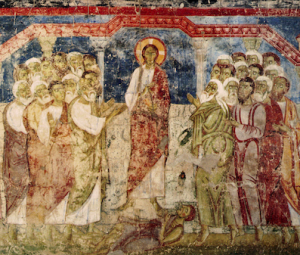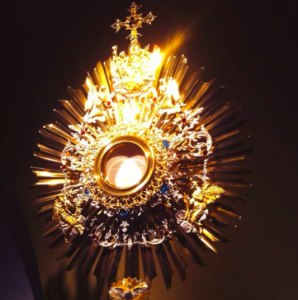Go here for an introduction to the rosary, and here for meditations on the Joyful Mysteries.
The Mysteries
The Luminous Mysteries are kind of the odd ones out. They’re a newly-instituted set, promulgated by St. John Paul II as recently as 2002; indeed, some Catholics prefer not to use them. They also focus on the “middle” of the Gospels, so to speak, drawing from the events of Christ’s ministry rather than from those commemorated around Christmas or the Easter season.
The mysteries themselves are as follows:
1. The Baptism of Christ in the Jordan
This, as advertised, covers Christ’s baptism.
2. The Miracle of Christ at Cana
This covers Christ turning the water into wine at the wedding of Cana, his first miracle.
3. The Proclamation by Christ of the Kingdom
This covers the inauguration of Christ’s ministry, which is presented slightly differently in each of the four Gospels—more on this below.
4. The Transfiguration of Christ on Tabor
Another straightforwardly-named mystery.
5. The Institution by Christ of the Eucharist
And yet a third.
The Proclamation of the Kingdom
This one is rather interesting, because each of the Gospels gives us a different perspective on it. In each one, this signifies the beginning of his public ministry, but the specific events (and sequence thereof) and resulting emphasis vary from text to text.

Fresco of Christ with the demoniac in the synagogue at Capernaum
John presents a slow build, with a handful of St. John the Baptist’s disciples “transferring” to following Jesus apparently on the Baptist’s own say-so. This is followed by the miracle at Cana (which describes it as confirming his disciples’ faith, but whose public status is unclear), and then hitting the scene explosively in Jerusalem with the cleansing of the Temple.1
Matthew and Mark begin with rather general descriptions of Jesus preaching after Herod2 had St. John the Baptist imprisoned. Matthew’s first specific story recounts Jesus calling his first disciples, the famous “fishers of men” passage, though it’s clear from the context that he had already been preaching for at least a little while in Capernaum by this point. (Indeed, we might guess such a thing even without the context, since four young fishermen would hardly be likely to leave behind everything they owned for a rando who came up to them and said “Come with me” apparently apropos of nothing.) Matthew goes from there to another general statement about preaching and miraculous healings, and then transitions to the Sermon on the Mount.
Mark also starts off with the calling of the first few disciples, but proceeds in a slightly different direction. Where Matthew gets into one of a number of extended discourses, Mark (a.k.a. “the cool one”) pivots to an abrupt public exorcism at a synagogue, followed by several miraculous healings and additional exorcisms, some described in detail.
Fourthly, Luke, though he hints at Christ’s early preaching like Matthew and Mark do, brings us into the scene when he returns to Nazareth. He preaches on the famous passage from Isaiah 61 (“The Spirit of the Lord is upon me, because he hath anointed me to preach good tidings”), receives an ultimately hostile reception from his old kith and kin for implying that God will show his generosity to the Gentiles, and is run out of the town.
Thus, the Gospel of John—our only source for the second Luminous Mystery—more or less treats that as the beginning of his public ministry, while the other three offer us slightly different versions of the third Luminous mystery. Matthew places the focus on his new interpretation of the Law, Mark on his spiritual power over evil, and Luke on the incipient mission to the Gentiles.
Meditations for the Luminous Mysteries

These are usually prayed a little less often than the other sets,3 and also happen to be the only set I frequently use “literal” meditations for.
1. The Baptism. John 1.29, Behold the Lamb of God, which taketh away the sin of the world. This quotation from St. John the Baptist does two things. First, it places the sacrament in the contexts of both the sacrificial system (especially the paschal lamb) and the New Covenant economy of forgiveness; second, since Christ’s baptism, superfluous to him, was an act of identification with the rest of humanity, it also forms a bridge between the Joyful Mysteries (themed around the Incarnation) and the Sorrowful (themed around the Passion).
2. Cana. John 2.11, Jesus manifested forth his glory; and his disciples believed on him. The Synoptic Gospels4 tend to deprecate “seeking after signs” and the dubious “faith” that this gives rise to. John occasionally does this too, but at other times he freely appeals to the witness of the miracles as a reason to have faith. Relying on spectacle as the ground of faith is clearly bad, but insofar as miracles leave us with facts (the former blind man can see now, the former demoniac is in his right mind now, etc.), we do have reason to recognize Jesus for what and who he is.
3. The Proclamation. Mark 1.15, The kingdom of God is at hand: repent ye, and believe in the gospel. To some extent, this phrase ties together the differing themes of the three Synoptics. We tend to use the word “kingdom” in a territorial sense, but the meaning of the Greek is something more like “kingship” or “rule”—the condition of sovereignty, rather than the place where it’s exercised. Christ’s authority to interpret the Law, to cast out demons, and to “conquer” the Gentiles are all expressions of this spiritual kingship held from the Father.
4. The Transfiguration. Matthew 17.5, This is my beloved Son, in whom I am well pleased; hear ye him. In addition to echoing the Father’s words at Christ’s baptism, this also ties the Transfiguration together with the story that immediately precedes it, that of St. Peter’s confession Thou art the Christ, itself immediately followed by Peter rebuking Christ for talking about his Passion and insisting it would never happen.
5. The Eucharist. John 6.54, Whoso eateth my flesh, and drinketh my blood, hath eternal life; and I will raise him up at the last day. Taken from the Bread of Life discourse rather than the institution narrative itself, this brings together Catholic belief about the sacrament and its connection to the Passion with our eschatological orientation as Christians: all things for us are oriented toward the Second Coming, the final union of creation with God.
Footnotes
1This is, of course, “out of order” chronologically. All of the evangelists—except possibly Mark—arrange their material at least partly thematically, to make theological points, and John perhaps most of all. Since the outline of Holy Week would already have been familiar to most Christians before John was written, in moving the cleansing of the Temple to the beginning, he puts his readers in mind of the ensuing trial. Together with his endless return to the language of witness and testimony (note that the first person Jesus speaks to after the cleansing of the Temple is Nicodemus, a Pharisee and probably a member of the Sanhedrin, and at night, too), this turns the whole Gospel into the notes of a trial, and all of the dialogue into a series of depositions and cross-examinations, inviting the reader to make a judgment.
2This is not Herod the Great, the king who tried to have Christ killed as a baby in Matthew 2, who died in or around 1 BC. This “Herod the Tetrarch” or Herod Antipas, one of the sons of Herod the Great. Ancient naming conventions were very odd to us: not only was it commonplace for children to be named for their parents, which is not unknown today, it was even normal to give multiple children the same name, distinguishing them by additional names, diminutives, and so on. This can make figuring out who’s who in ancient records a real pain in the neck!
3There’s a weekly cycle many people use in praying the rosary. Monday, Tuesday, and Wednesday get the Joyful, Sorrowful, and Glorious Mysteries respectively, and Thursday, Friday, and Sunday get the Luminous, Sorrowful, and Joyful Mysteries respectively (thus giving us two slightly different summaries of the Gospels per week). Saturday, the odd day out, also happens to be traditionally associated with the Virgin, and is set aside for the Joyful Mysteries. This means that on this schedule, the three older sets of mysteries are each prayed twice, but the Luminous Mysteries only once.
4I.e., Matthew, Mark, and Luke. They share a large amount of material not found in John (and much of John’s material is not found in them), and tend to agree in broad strokes about chronology. They are thus called synoptic from the Greek for “seeing together,” syn-optic.












